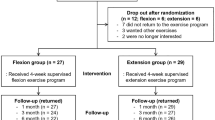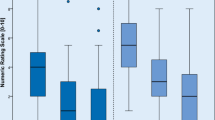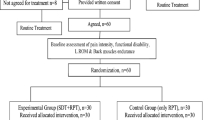Abstract
Many clinical trials on chiropractic management of low back pain have neglected to include specific forms of care. This study compared two well-defined treatment protocols. The objective was to compare the outcome of flexion–distraction (FD) procedures performed by chiropractors with an active trunk exercise protocol (ATEP) performed by physical therapists. A randomized clinical trial study design was used. Subjects, 18 years of age and older, with a primary complaint of low back pain (>3 months) were recruited. A 100 mm visual analogue scale (VAS) for perceived pain, the Roland Morris (RM) Questionnaire for low back function, and the SF-36 for overall health status served as primary outcome measures. Subjects were randomly allocated to receive either FD or ATEP. The FD intervention consisted of the application of flexion and traction applied to specific regions in the low back, with the aid of a specially designed manipulation table. The ATEP intervention included stabilizing and flexibility exercises, the use of modalities, and cardiovascular training. A total of 235 subjects met the inclusion/exclusion criteria and signed the informed consent. Of these, 123 were randomly allocated to FD and 112 to the ATEP. Study patients perceived significantly less pain and better function after intervention, regardless of which group they were allocated to (P<0.01). Subjects randomly allocated to the flexion–distraction group had significantly greater relief from pain than those allocated to the exercise program (P=0.01). Subgroup analysis indicated that subjects categorized as chronic, with moderate to severe symptoms, improved most with the flexion–distraction protocol. Subjects categorized with recurrent pain and moderate to severe symptoms improved most with the exercise program. Patients with radiculopathy did significantly better with FD. There were no significant differences between groups on the Roland Morris and SF-36 outcome measures. Overall, flexion–distraction provided more pain relief than active exercise; however, these results varied based on stratification of patients with and without radiculopathy and with and without recurrent symptoms. The subgroup analysis provides a possible explanation for contrasting results among randomized clinical trials of chronic low back pain treatments and these results also provide guidance for future work in the treatment of chronic low back pain.




Similar content being viewed by others
References
Andersson GB (1999) Epidemiological features of chronic low-back pain. Lancet 354:581–585
Assendelft WJ, Morton SC, Yu EI, Suttorp MJ, Shekelle PG (2003) Spinal manipulation for low back pain. A meta-analysis of effectiveness relative to other therapies. Ann Intern Med 138:881
Beaton DE, Hogg-Johnson S, Bombardier C (1997) Evaluating changes in health status: reliability and responsiveness of five generic health status measures in workers with musculoskeletal disorders. J Clin Epidemiol 50:79–93
Childs JD, Fritz JM, Flynn TW, Irrgang JJ, Johnson KK, Majkowski GR, Delitto A (2004) A clinical prediction rule to identify patients with low back pain most likely to benefit from spinal manipulation: a validation study. Ann Intern Med 141:920–928
Christensen MG, Kerkoff D, Kollasch MW (2000) Job analysis of chiropractic, 2000. National Board of Chiropractic Examiners, Greeley
Cox JM (1999) Low back pain: mechanism, diagnosis, treatment. 6th edn. Lippincott Williams & Wilkins, Baltimore
Cox JM, Gudavalli MR (2005) Traction and distraction techniques. In: Haldeman S, Dagenais S, Budgell B, Grunnet-Nilsson N, Hooper PD, Meeker WC, Triano J (eds) Principles and practice of chiropractic. 3rd edn. McGraw-Hill, New York, pp 821–840
Deyo RA, Phillips WR (1996) Low back pain. A primary challenge. Spine 21:2826–2832
Flynn T, Fritz J, Witman J, Wainner R, Magel J, Rendeiro D, Butler B, Garber M, Allison S (2002) A clinical prediction rule for classifying patients with low back pain who demonstrate short-term improvement with spinal manipulation. Spine 27:2835–2843
Furlan AD, Brosseau L, Imamura M, Irvin E (2002) Massage for low back pain. Cochrane Database Syst Rev (2):CD001929
Gatchel RJ (ed) (2001) Compendium of outcome instruments for assessment and research of spinal disorders. North American Spine Society, LaGrange
Gudavalli MR, Cox JM, Baker JA, Cramer GD, Patwardhan AG (1997) Intervertebral disc pressure changes during the flexion–distraction procedure for low back pain. In: Proceedings of the 1997 annual International Society for the Study of the Lumbar Spine, Singapore, p 165
Gudavalli MR, Cox JM, Baker JA, Cramer GD, Patwardhan AG (1997) Intervertebral disc pressure changes during a chiropractic procedure for low back pain. American Society of Mechanical Engineers bioengineering conference, Dallas, TX, pp 215–216
Gudavalli MR, Cox JM, Cramer GD, Baker JA, Patwardhan AG (2000) Vertebral motions during flexion–distraction treatment for low back pain. 2000 ASME international mechanical engineering congress and exposition, Orlando, FL, pp 129–130
Helmhout PH, Harts CC, Staal JB, Candel MJ, de Bie RA (2004) Comparison of a high-intensity and a low-intensity lumbar extensor training program as minimal intervention treatment in low back pain: a randomized trial. Eur Spine J 13:537–547
Huskisson EC (1982) Measurement of pain. J Rheumatol 9:768–769
Katz N, Rodgers DB, Krupa D, Reicin A (2004) Onset of pain relief with rofecoxib in chronic low back pain: results of two four-week, randomized, placebo-controlled trials. Curr Med Res Opin 20:651–658
Koes BW, Assendelft WJ, van der Heijden GJ, Bouter LM (1996) Spinal manipulation for low back pain. An updated systematic review of randomized clinical trials. Spine 21:2872–2873
Lubeck DP (2003) The costs of musculoskeletal disease: health needs assessment and health economics. Best Pract Res Clin Rheumatol 17:529–539
Mayer TG, Gatchel RJ, Evans TH (2002) Chronic low back pain. In: Fitzgerald RH, Kaufer H, Malkani AL (eds) Orthopaedics. Mosby, St Louis, pp 1192–1197
McDowell I, Newell C (1996) Measuring health: a guide to rating scales and questionnaires. Oxford University Press, New York
Mior S (2001) Exercise in the treatment of chronic pain. Clin J Pain 17:S77–S85
Mior S (2001) Manipulation and mobilization in the treatment of chronic pain. Clin J Pain 17:S70–S76
Murphy DR, Morris C (2005) Manual examination of the patient. In: Haldeman S, Dagenais S, Budgell B, Grunnet-Nilsson N, Hooper PD, Meeker WC, Triano J (eds) Principles and practice of chiropractic. 3rd edn. McGraw-Hill, New York, pp 593–610
Nielson WR, Weir R (2001) Biopsychosocial approaches to the treatment of chronic pain. Clin J Pain 17:S114–S127
Niemisto L, Kalso E, Malmivaara A, Seitsalo S, Hurri H (2003) Radiofrequency denervation for neck and back pain. A systematic review of randomized controlled trials. Cochrane Database Syst Rev (1):CD004058
Ohnmeiss DD, Rashbaum RF (2001) Patient satisfaction with spinal cord stimulation for predominant complaints of chronic, intractable low back pain. Spine J 1:358–363
O’Sullivan PB (2000) Lumbar segmental ‘instability’ clinical presentation and specific stabilizing exercise management. Man Ther 5:2–12
O’Sullivan PB, Phyty GD, Twomey LT, Allison GT (1997) Evaluation of specific stabilizing exercise in the treatment of chronic low back pain with radiologic diagnosis of spondylolysis or spondylolisthesis. Spine 22:2959–2967
Roland M, Morris R (1983) A study of the natural history of back pain. Part I: development of a reliable and sensitive measure of disability and low back pain. Spine 8:141–144
Triano JJ, McGregor M, Hondras MA, Brennan PC (1995) Manipulative therapy versus education programs in chronic low back pain. Spine 20:948–955
van Tulder M, Malmivaara A, Esmail R, Koes B (2000) Exercise therapy for low back pain: a systematic review within the framework of the Cochrane collaboration back review group. Spine 25:2784–2796
Turk DC (2005) The potential of treatment matching for subgroups of patients with chronic pain: lumping versus splitting. Clin J Pain 21:44–55
Vollenbroek-Hutton MMR, Hermens HJ, Wever D, Gorter M, Rinket J, Ijzerman MJ (2004) Differences in outcome of a multidisciplinary treatment between subgroups of chronic low back pain patients defined using two multiaxial assessment instruments: the multidimensional pain inventory and lumbar dynamometry. Clin Rehabil 18:566–579
Acknowledgements
The authors thank the Health Resources and Services Administration (HRSA) for their financial support (Grant # R18 AH 10001), National Chiropractic Mutual Insurance Company, and many chiropractic physicians for their generous donations. We also thank James Cox, DC and Timothy Carey, PhD, Rita Ator, PT for providing invaluable consultation and the clinicians, physical therapists, student assistants, study patients, and clinic support staff for their help with this study.
Author information
Authors and Affiliations
Corresponding author
Rights and permissions
About this article
Cite this article
Gudavalli, M.R., Cambron, J.A., McGregor, M. et al. A randomized clinical trial and subgroup analysis to compare flexion–distraction with active exercise for chronic low back pain. Eur Spine J 15, 1070–1082 (2006). https://doi.org/10.1007/s00586-005-0021-8
Received:
Revised:
Accepted:
Published:
Issue Date:
DOI: https://doi.org/10.1007/s00586-005-0021-8




